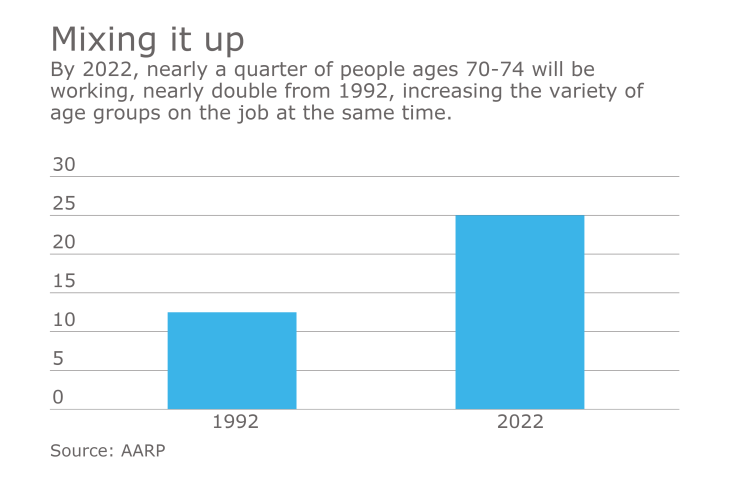A combination of low unemployment, the ongoing surge in baby boomers retiring and intergenerational issues, 2017 is shaping up to be a challenging time for human resources.
From preparing Generations X and Y to replace baby boomers in leadership positions and enticing more demanding millennials to finding compliance talent and integrating divergent staffs post-merger, HR executives cited a variety of issues they expect to be tackling this year.
Jackie Henderson, vice president of human resources at Rivermark Community Credit Union, a $780-million institution based in Beaverton, Ore., said leadership development is one of her hot topics right now.
“This means educating the different generations about each other and coaching to strengths rather than pointing out weaknesses,” she told CU Journal. “It’s learning about preferences and respecting differences. [This is] not so different then when the veterans [of World War II and Korean War] were beginning to leave the workforce and [baby boomers were] entering and moving up.”
It’s vital to make sure a boomer employee’s legacy of knowledge and experience doesn’t disappear when he or she retires, Henderson said. “We try to get out in front of that curve, and meet with employees to tap into that knowledge and document what they know and what they do, so that when they leave, their expertise doesn’t just walk out the door,” she said.
With unemployment low in many areas of the country, credit unions are seeing more competition in recruiting and retaining talent, as well.

Ent Credit Union is a $4.7-billion institution based in Colorado Springs, Colo. – a city which had a jobless rate of only 3.2% as of November 2016 (according to the Bureau of Labor Statistics). Due to these modest unemployment numbers, it has become harder and harder for credit unions and other businesses to retain entry-level talent.
“It’s quite a challenge to keep entry-level workers like tellers or member service representatives,” Bob Walla, Ent CU’s director of employment, relations and welfare, told CU Journal.
“Once we hire them, we have to find ways to keep them motivated and on the job for the long-term. Our low turnover rate becomes the challenge in meeting their career aspirations in career growth and mobility. I think other credit unions across the nation will also face this phenomenon.”
Rivermark’s Henderson agreed, noting the credit union is exploring more flexible work arrangments, including flex time and telecommuting.
In addition to offering a better work-life balance, she said, it also can save the credit union money. As Rivermark gets closer to reaching capacity at its building, such arrangements can mitigate the need for finding more office space.
Sara Holland, the manager of benefits and recruiting at Ent, noted the CU has a relatively low annual turnover rate of about 15% (for all levels). To achieve this, Ent has encouraged continuing education with tuition reimbursement, career counseling and training and development initiatives, Holland explained, adding, “we are big believers in promoting from within.”
Given the ever-escalating wave of regulations, another key challenge for credit union HR executives is finding compliance talent—either by recruiting and hiring someone from outside, or developing it internally.
“It is difficult to find experienced, well-rounded [compliance] talent,” said Jason Harpenau, business development manager at PolicyWorks LLC of Des Moines, Iowa, adding that the scope of rules to keep up with makes it difficult for just one person to be on top of it all.
To attract and retain people with this unique skill set, credit unions will likely have to raise salaries for compliance employees, noted Brian Godwin, director of compliance solutions at PolicyWorks. Gary Fillman, director of risk advisory services for Centris Federal Credit Union, a $656-million institution based in Omaha, agreed.
“The challenge we face in a market like ours is large employers can pay top dollar for compliance expertise,” Fillman said. “When you’re looking for someone who can hit the ground running, you have to be prepared to compensate that person at a competitive rate to keep him or her for the long term.”
Barring that, some CUs will need to look at outsourcing their compliance operations, Godwin suggested.
Another area of focus: organizational development and training, which Henderson said will start out with doing away with traditional annual performance reviews in favor of setting shorter-term goals and gathering more frequent feedback.
“I believe the day of the annual review has long run its course,” Henderson commented. “To be more effective and to really engage employees, managers need to be providing feedback more regularly. The idea of having a meeting once a year where an entire year of performance is rated (or whatever the manager recalls) is archaic and needs to be replaced.”
Henderson suggesting moving to quarterly two-way dialogues exploring which of the previous goals were set, what worked and what didn’t and establishing the next set of goals.
“It will serve to help the organization achieve its goals in smaller, bite-sized chunks,” Henderson noted. “It also gives employers the opportunity to reward high performers more frequently, and to manage underperformers before a problem really has time to cultivate.”
Meanwhile, as the industry continues to consolidate, mergers offer another HR challenge: integrating divergent staffs. While most industries are quick to capitalize on mergers by letting people go, credit unions are loathe to do so, forcing HR to find places for people within the merged organization and to weave varying corporate cultures together.
Most mergers involve a larger credit union acquiring a smaller credit union, but the culture at that smaller credit union is every bit as long-established as at the larger CU, Rivermark’s Henderson related.
“The smaller credit union is usually expected to acclimate to the larger credit union’s culture, which is almost always more structured and corporate then they are accustomed to,” she commented. “Their policies and philosophies may vary greatly. In smaller credit unions, the employees may be wearing multiple hats, [whereas] in a larger credit union, employees typically perform just one role. It’s a cultural shift and it takes time, patience, and understanding to make it work.”





